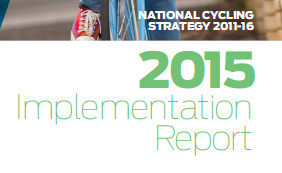This is a guest post by Chris Gillham, who maintains http://www.cycle-helmets.com/, a rich repository of facts and statistics on Australia’s helmet law disaster.
A report on cycling promotion by the Australian Bicycle Council and Austroads will test whether the Australian or New Zealand governments are paying any attention to the cycling participation and safety obstacles created by their all-age mandatory helmet laws.
The National Cycling Strategy Implementation Report 2015 (http://www.bicyclecouncil.com.au/files/publication/NCS_ImplementationReport2015.pdf) evaluates the progress of the 2011-16 national strategy to double Australia’s cycling participation.
The report confirms the abject failure of the strategy and acknowledges that not only was there no increase in participation, there was a slight decrease from 2011 to 2015. Australia’s weekly cycling participation was down 0.8% from 18.2% in 2011 to 17.4% in 2015, representing about 187,000 fewer cyclists.
The population proportion cycling at least once a month dropped from 27.1% in 2011 to 24.3% in 2015, representing about 690,000 people, and cycling at least once a year dropped from 40.2% to 36.3%, or about 950,000 fewer cyclists.
Governance of the National Cycling Strategy ranges from ministerial oversight in all Australian and NZ jurisdictions to all relevant government departments and agencies in both countries.
If any of them reads the report, they’ll find it itemises the 2011-16 strategy successes of improved infrastructure and more cycleways, along with promotional events and participation/safety campaigns by the different states.
All amounting to fewer people cycling and more being injured.
The report doesn’t say it explicitly but repeatedly suggests that helmet laws are an obstacle to participation and safety.
For example, the following is about a third of the report’s summary on road safety:
While most of Australia has all-age mandatory bicycle helmet laws, the Northern Territory allows people over the age of 17 to ride without a helmet under certain circumstances such as on bicycle paths and footpaths (footpath cycling is legal in the Northern Territory).
Despite more relaxed laws regarding footpath cycling and helmet use, the report found that the Northern Territory had the lowest proportion of both cycling fatalities and hospitalisations as a proportion of all traffic fatalities/crashes by jurisdiction in the period 2005-2014.
The low proportion of fatalities and hospitalisations in the Northern Territory cannot be explained due to low cycling participation. In fact, in 2015 the Northern Territory had the highest level of weekly (24.1%), monthly (32.6%) and yearly (46.1%) cycling participation in Australia.
Are the ABC and Austroads giving a hint when they introduce their chapter on cycling promotion with the following?
An undue focus on safety and on the need for special safety precautions reduces the appeal of cycling and unfairly places the responsibility on the cyclist to protect themselves from external dangers.
The report concedes an insignificant decline in Australian weekly cycling participation from 2011 to 2015 (187,000 fewer cyclists). However, it’s important to note that while the 0.8% decline in weekly participation wasn’t considered significant, when trip per week estimates in the 2011 and 2015 survey reports are applied, the reduction in Australias daily cycling participation was very significant.
In fact, trip per week changes in all Australian states resulted cumulatively in a 41.3% decline in national daily bike trips from 2011 to 2015.
That’s about 1.3 million fewer bike trips per day, confirming that Australian daily bicycle trips are way down on estimates from surveys before the 1990-92 introduction of bicycle helmet laws. Australia’s population increased 39.4% from 1990 to 2015.
Australia had 7,520 hospitalised cyclist injuries in 1990 and 10,098 in 2013, a 34.3% increase.
The report notes: “The National Cycling Strategy finishes at the end of 2016 and there are no plans to develop a future strategy for cycling in Australia.”
Perhaps governments do not want to be reminded that their promises to get more people cycling are empty. They prefer to shut down the messenger rather than address the real problems. Meanwhile increased cycling participation is a cure for road safety, public health, traffic congestion and greenhouse gases but Australian Governments are giving up.
The National Cycling Strategy Implementation Report 2015 demonstrates that despite more cycling infrastructure and government participation/safety campaigns, there are fewer cyclists and more injuries.
The elephant in the room is mandatory helmet laws and it will be interesting to see if the Australian and New Zealand government representatives who’ve received the report will read it or get the hint that helmet laws are harming instead of improving cyclist participation and safety.
The National Cycling Strategy Implementation Report 2015 also adds weight to the need for Australia’s Senate to reconvene the Personal Choice and Community Impacts committee of inquiry into bicycle helmet laws (http://www.freestylecyclists.org/senate-enquiry-helmet-laws/ & http://www.freestylecyclists.org/senate-committee-public-hearing/).


Interesting isn’t that a large amount of British cyclists appear to wear helmets. Why? Because they choose to rather than being made to…
The 2017 National Cycling Participation Survey report has been published by Austroads and the Australian Bicycle Council.
The report confirms that Australian cycling participation has been in significant decline for the past six years. This is a national public health and road safety disaster.
The report also confirms Australia’s cycling decline is expected to continue in future because the demographic bulge of baby boomers who learnt and loved cycling in their helmet-free youth, and who have increased participation since the 1990-92 helmet law cycling collapse, are now retiring their bikes because of their age.
However, they aren’t being replaced by younger people who learnt many years ago that they will be punished for enjoying regular and healthy cycling exercise in what has become the second fattest country on earth.
The 2017 NCP survey report has been available for more than 24 hours but there is so far no media coverage in Australia. However, a link and basic summary can be viewed at http://www.cycle-helmets.com/cycling-1985-2017.html.